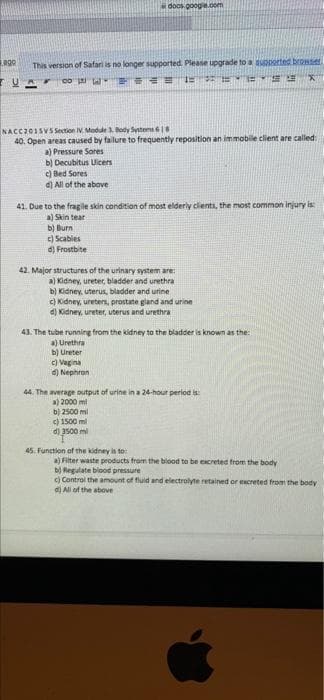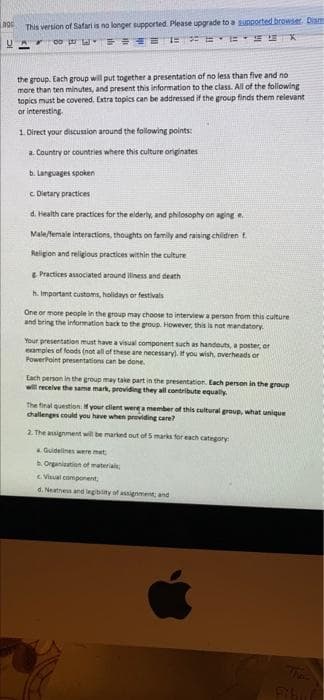ACCI01SV5 Section IV 40. Open areas caused by failure to frequently reposition an immobile client are called: a) Pressure Sores bị Decubitus Uicers ) Bed Sores d All of the above
ACCI01SV5 Section IV 40. Open areas caused by failure to frequently reposition an immobile client are called: a) Pressure Sores bị Decubitus Uicers ) Bed Sores d All of the above
Biomedical Instrumentation Systems
1st Edition
ISBN:9781133478294
Author:Chatterjee
Publisher:Chatterjee
Chapter24: New Technologies And Advances In Medical Instrumentation
Section: Chapter Questions
Problem 1RT
Related questions
Question

Transcribed Image Text:doos.google.0om
This version of Safari is no longer supported. Please upgrade to a dupported browter
NACC201SV S Section IV. Module Body Systems 68
40. Open areas caused by failure to frequently reposition an immobile client are called:
a) Pressure Sores
b) Decubitus Uicers
c) Bed Sores
d) All of the above
41. Due to the fragile skin condition of most elderly cients, the most common injury is
a) Skin tear
b) Burn
E) Scabies
d) Frostbite
42. Major structures of the urinary system are:
a) Kidney, ureter, bladder and unrethra
b) Kidney, uterus, bladder and urine
c) Kidney, ureters, prostate gland and urine
d) Kidney, ureter, uterus and urethra
43. The tube running from the kidney to the bladder is known as the:
a) Urethra
b) Ureter
) Vagina
d) Nephron
44. The average output of urine in a 24-hour period is:
a) 2000 ml
b) 2500 ml
c) 1500 ml
d) 3500 ml
45. Function of the kidney is to:
a) Filter waste products from the blood to be excreted from the body
b) Regulate biood pressure
) Control the amount of fluid and electrolyte retained or excreted from the body
di Al of the above

Transcribed Image Text:[noc
This version of Satari is no longer supported. Please upgrade to a sunported browser Dism
the group. Each group will put together a presentation of no less than five and no
more than ten minutes, and present this information to the class. All of the folowing
topics must be covered. Extra topics can be addressed if the group finds them relevant
or interesting
1. Direct your discussion around the following points:
a Country or countries where this culture originates
b. Languages spoken
C Dietary practices
d. Health care practices for the elderly, and philosophy on aging
Male/female interactions, thoughts on family and raising chidren f.
Religion and religious practices within the culture
E Practices associated around iliness and death
h. Important customs, holidays or festivals
One or more people in the group may choose to interviewa person from this culture
and bring the information back to the group. However, this is not mandatory.
Your presentation must have a visual component such as handouts, a poster, or
eamples of foods (not all of these are necessary). It you wish, overheads or
PowerPoint presentations can be done.
Each person in the group may take part in the presentation. Each person in the group
wil recelve the same mark, providing they all contribute equaly.
The final question. if your dient were a member of this cuitural group, what unique
challenges could you have when providing care?
2. The asignment will be marked out of 5 marks for each category
Guidelines were mat
. Organiation of materia
Visual comgonent
d. Neatness and legibity of asignment and
Expert Solution
This question has been solved!
Explore an expertly crafted, step-by-step solution for a thorough understanding of key concepts.
Step by step
Solved in 2 steps

Recommended textbooks for you


Health Safety And Nutrition F/Young Child
Health & Nutrition
ISBN:
9781305144767
Author:
MAROTZ
Publisher:
Cengage


Health Safety And Nutrition F/Young Child
Health & Nutrition
ISBN:
9781305144767
Author:
MAROTZ
Publisher:
Cengage